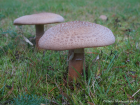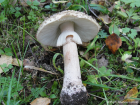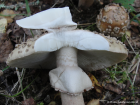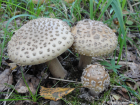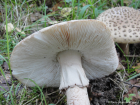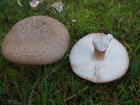Cap pinkish-brown with grey to pink patches on the surface. At first, it is sub-spherical, becoming convex and finally flattened. The flesh is moderately firm and white, becoming brownish pink were cut or damaged. Gills crowded, soft, white to off-white, free from the stem, with pink tinges appearing on damaged areas. Stem downy, grey, white, or pink, bears a prominent pendent ring with furrows on its upper surface. The base is swollen and girdled and lacks a sacklike volva. Spore print white.
Microscopic Features: The spores are broadly ellipsoidal to ovoid in shape, with a smooth surface. They measure 8-9 µm in length and 5-5.5 µm in width. They are amyloid.
Similar species include Amanita pantherina.
Amanita rubescens on the First Nature Web site.
Amanita rubescens on the MushroomExpert.Com Web site.
Many mushrooms are poisonous, and some can be lethally toxic. Distinguishing between edible and poisonous mushrooms can be very challenging. Therefore, we strongly advise against consuming wild mushrooms. This website does not contain any information about the edibility or toxicity of mushrooms.
Although efforts have been made to ensure accuracy on this website, the information may contain errors and omissions. Therefore, all content provided is for educational and informational purposes only and should not be relied upon or used as a basis for consuming any plants or mushrooms.
External links are provided for reference only. We do not endorse or take responsibility for the content, advice, or products found on these sites or in any advertisements shown on this website.
